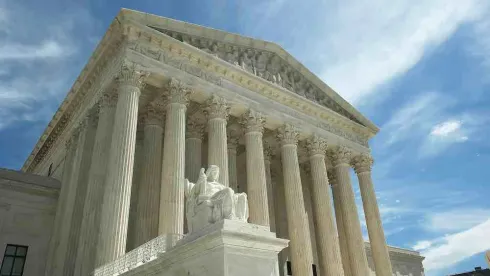On October 29, 2021, the U.S. Supreme Court agreed to hear an appeal of the D.C. Circuit’s decision vacating the Affordable Clean Energy (ACE) rule, the Trump Administration’s action to address CO2 emissions from existing fossil-fired power plants. This marks the latest development in a legal fight over what authority the Clean Air Act confers on the Environmental Protection Agency (EPA) to regulate greenhouse gas (GHG) emissions from the power sector—a fight that has spanned over six years and three presidential administrations. Depending on the outcome, the Court could open the door to significant new regulations or tie the Biden Administration’s hands by restricting the scope of EPA’s authority under Section 111(d) of the Clean Air Act.
Key Takeaways
-
The Supreme Court will review a lower court’s conclusion that the Trump administration erred in concluding that only certain on-site emission-reduction measures can be the “best system of emission reduction” for existing power plants under Section 111(d) of the Clean Air Act.
-
If the Court agrees with the Trump Administration’s construction of the statute, it would significantly limit the scope of measures the Biden Administration could rely upon in its expected rule promulgating emission guidelines for CO2 emissions from existing power plants.
-
Absent a Supreme Court ruling to the contrary, it is likely that the Biden EPA would use Section 111(d) to impose “beyond the fenceline” measures to drive emissions reductions in the power sector.
-
The power sector is key to achieving President Biden’s GHG reduction objectives, and EPA Administrator Regan has made it clear that the EPA will forge ahead with a replacement for the ACE Rule irrespective of the pending review by the Supreme Court.
Analysis
As we have previously discussed at length, the ACE Rule replaced the Obama Administration’s much more far-reaching Clean Power Plan. The legal foundation for both rules was Section 111(d), which requires EPA to establish emissions guidelines based on the “degree of emission limitation achievable through application of the best system of emission reduction” that has been “adequately demonstrated” for existing stationary sources of air pollution.
A key legal foundation of the Clean Power Plan was EPA’s view that Section 111(d)’s prescription for the “best system of emission reduction” is broad enough to encompass off-site measures that have the effect of reducing coal-fired power plant emissions, such as shifting generation to natural gas-fired or renewable generation plants (colloquially, “beyond the fenceline” measures). By contrast, the Trump Administration’s far more limited ACE Rule was premised on a conclusion that Section 111(d) unambiguously limits the “best system of emission reduction” to measures applied “at and to the source” (i.e., inside the fenceline). Both of these rules were challenged on various grounds, but one vital issue is whether EPA has authority to impose off-site emissions reduction measures through a Section 111(d) rule.
The D.C. Circuit vacated the ACE Rule on January 19, 2021. In doing so, the D.C. Circuit concluded that the Trump EPA had read Section 111(d) too narrowly to prohibit beyond the fenceline measures, and vacated and remanded the ACE Rule to EPA to consider “afresh.” If the Supreme Court disagrees with the D.C. Circuit and concludes that the statute does in fact permit only “inside the fenceline” measures, the Biden Administration’s efforts to address GHGs from existing fossil-fired plants under the Clean Air Act is likely to be constrained.
Notably, the Court granted review only on statutory and constitutional questions relevant to the scope of measures lawfully considered under Section 111(d). It elected not to hear a second question advanced by industry petitioners, who argued that coal-fired power plants could not be regulated at all under Section 111(d), because the same sources are regulated under Section 112 of the Clean Air Act. The Section 111(d) question has been extensively briefed in other cases related to the Clean Power Plan and the ACE Rule, and petitioners are likely to refresh those arguments while focusing on the scope of authority granted by Congress to EPA under Section 111(d). On the other hand, EPA and other respondents are likely to focus on the procedural posture of the case (with no live rule actually in dispute) as well as EPA’s authority under Section 111(d) based on statutory interpretation and underlying Congressional intent.
With Congress unlikely to act on broad GHG reductions for the power sector any time soon, the Biden Administration has made it clear that it will use all available regulatory tools to drive GHG cuts. EPA Administrator Michael Regan recently indicated that the Supreme Court’s review of the ACE Rule litigation will not slow the agency’s development of its 111(d) Rule, reportedly telling Reuters that: “EPA will continue to move forward and use its statutory authority to be sure that we protect the public from harmful pollution, greenhouse gas pollution and pollution that contributes to the degradation of air quality.”
With a Supreme Court challenge and EPA rulemaking proceeding in parallel, one thing is certain: the next year will prove pivotal for GHG regulation in the power sector.





 />i
/>i

